The Nexus 7 (2013) Review
by Anand Lal Shimpi on August 22, 2013 6:00 PM ESTCPU Performance
The while the original Nexus 7 was fast for the money, the new Nexus 7 is just fast. Moving away from NVIDIA to Qualcomm, ASUS and Google settled on the APQ8064 Pro. Although we originally assumed this would be a quad-core Krait 200 based SoC, Brian's teardown revealed the part number 8064-1AA. What's special about that part number is it implies newer Krait 300 cores, making the SoC effectively a Snapdragon 600.
The CPU cores can run at up to 1.5GHz, putting it a bit lower than what we've seen from Snapdragon 600 based phones (e.g. HTC One tops out at 1.7GHz, while the US SGS4 hits 1.9GHz).
I was curious as to the impact of the lower frequency when combined with the potentially higher chassis TDP so I compared the Nexus 7 to the US Galaxy S 4. I turned to Geekbench because it offers a nicely woven mixture of single and multithreaded benchmarks, letting me look at peak available single core performance as well as what happens when multiple cores are active and working.
In this first graph we're looking at the first Krait 300 core running the workload. I've zoomed in to a small portion of the benchmark so we can get a better idea of CPU behavior:
The Nexus 7's CPU0 is almost always pegged at 1.5GHz whereas we see a lot of bursty thermal management on the smaller SGS4. This isn't unexpected, but what ends up happening is the sustained performance advantage drops from a peak theoretical max of 26% down to a more reasonable average gain of ~8%.
I was curious to see if multithreaded workloads showed any different behavior. Here we're looking at the fourth CPU core (CPU3). Note that it's not always active, which is why you see parts of the graph drop down to 0KHz. Once again we see similarly static behavior from the Nexus 7. Even with all four cores active, when you need the performance the Nexus 7 delivers a full 1.5GHz. These tests are short enough where we don't see tremendous swings in frequency, but once again we do see some frequency modulation in a smaller chassis.
The end result is that the Nexus 7's 1.5GHz Krait 300 cores are slower than what you'd get in a Galaxy S 4, however the gap isn't nearly as large as you'd expect it to be thanks to the larger chassis and how the platform is tuned. The Nexus 7 can run at 1.5GHz more consistently than Snapdragon 600 based phones can run at 1.7/1.9GHz.
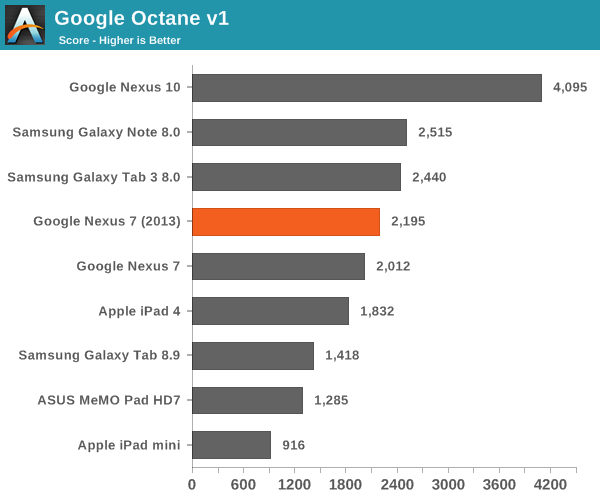
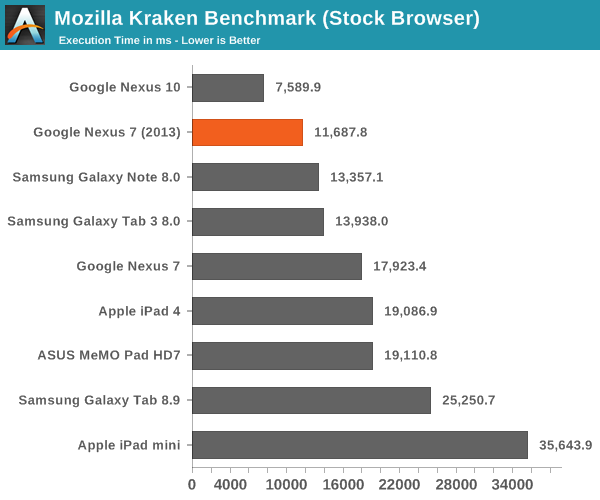
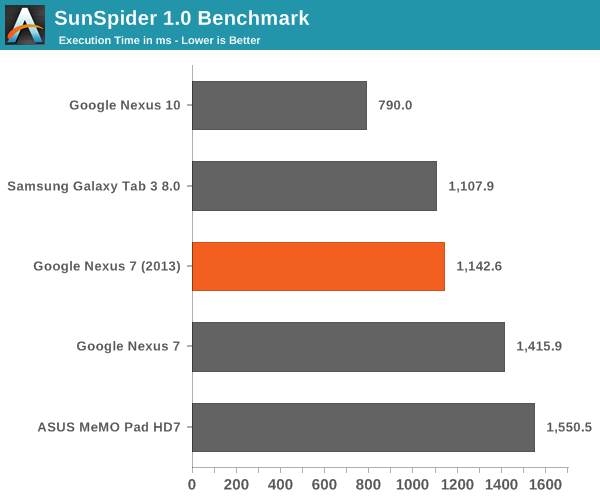
The GPU
Qualcomm seems to be frequency binning here, which is standard industry practice. Using binning to create these different SKUs gives Qualcomm pricing flexibility and also gives it the option to give large customers special treatment.
On the graphics side Qualcomm's Adreno 320 GPU makes an appearance. Clock speeds are also limited to 400MHz, compared to 450MHz for the high-end Snapdragon 600 implementations we've seen.
The APQ8064-1AA's dual-channel memory controller is populated with four x 16-bit DDR3L-1600 memory devices, giving the Nexus 7 a healthy amount of memory bandwidth. Peak memory bandwidth available to the APQ8064-1AA is 12.8GB/s, equalling what's available to Apple's A5X in the 3rd generation iPad with Retina display. Tons of memory bandwidth is obviously a pre-requisite for driving a high resolution display, and the combination of DDR3L-1600 and the Adreno 320 GPU delivers a butter smooth UI in all well written Android apps.
Although CPU performance is somewhat middle of the road compared to the rest of the landscape, GPU performance is faster than any other Nexus device on the market - and pretty much faster than any other similarly sized tablet:
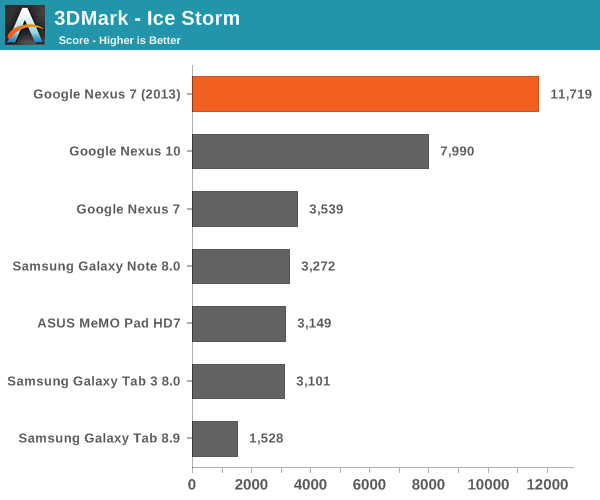
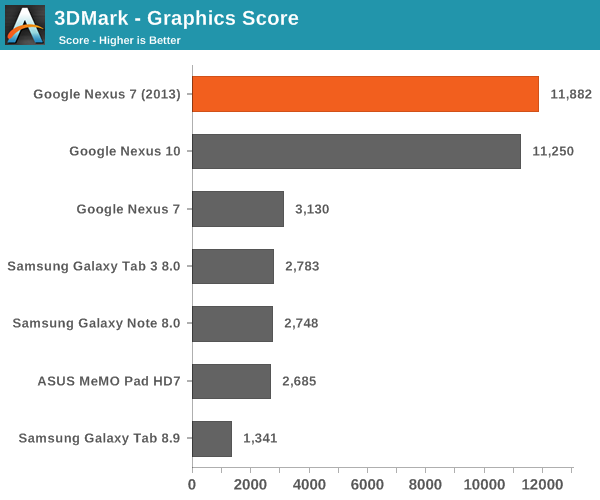
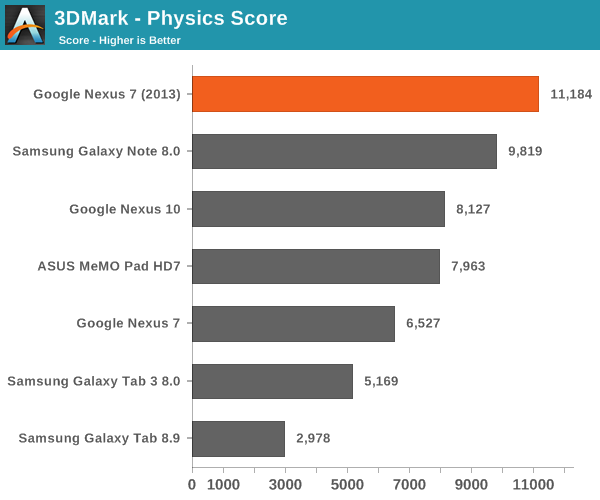
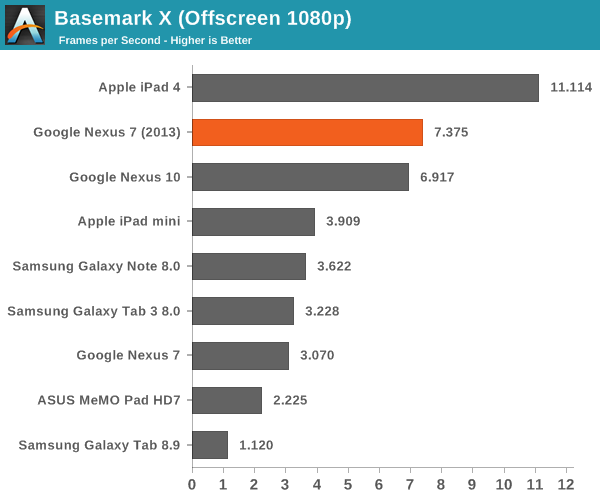
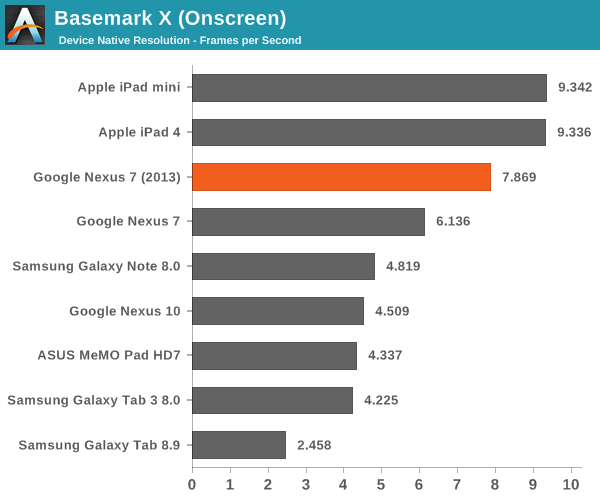
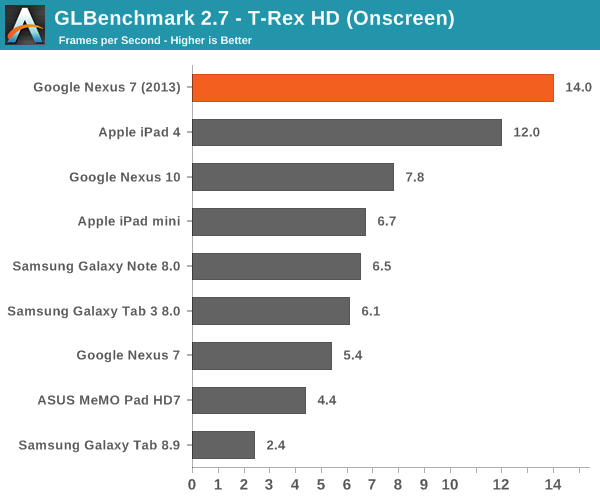
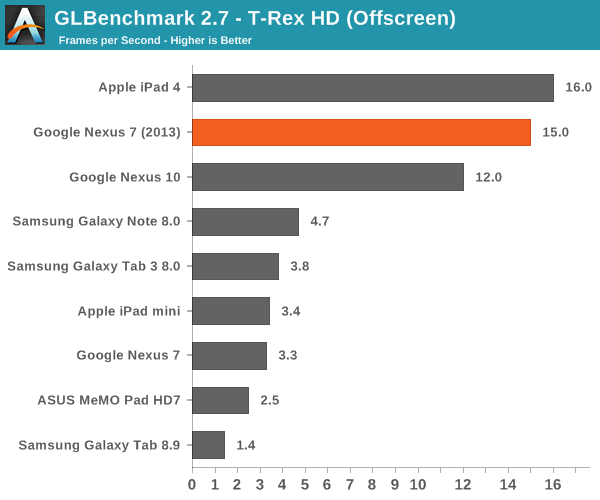
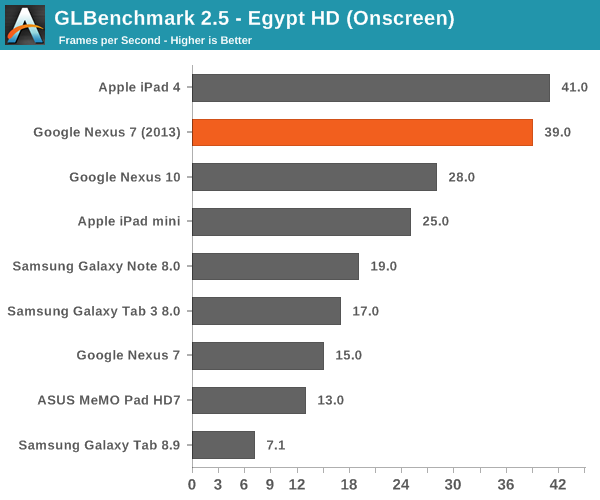
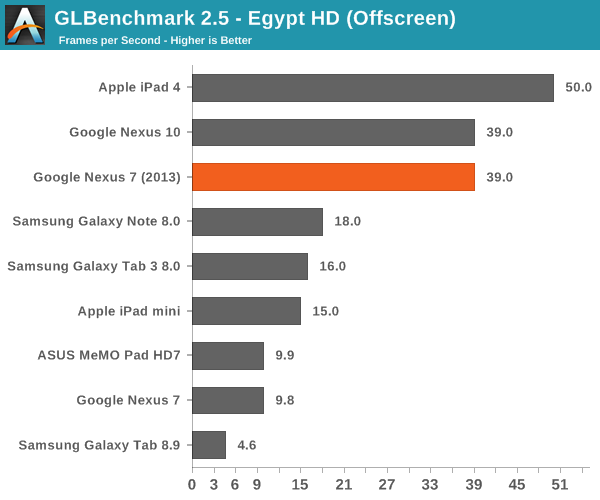
I played Modern Combat 4 as well as Shadowgun, both demanding 3D titles, on the new Nexus 7. Both titles appeared to render at the Nexus 7's native 1920 x 1200 resolution, and both appeared to do so at around 30 fps.


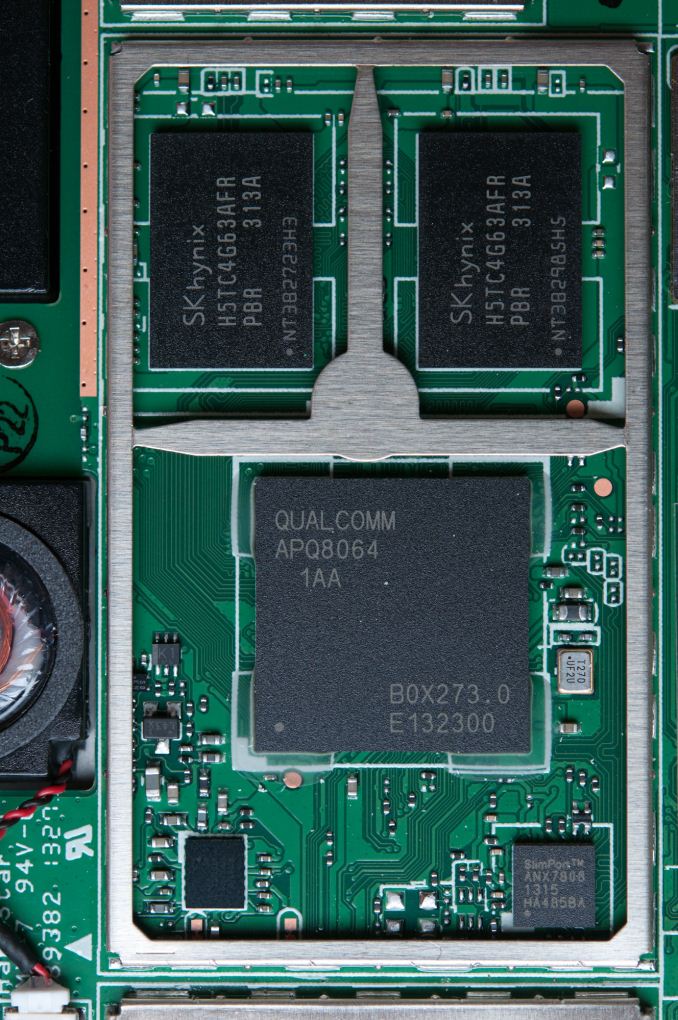
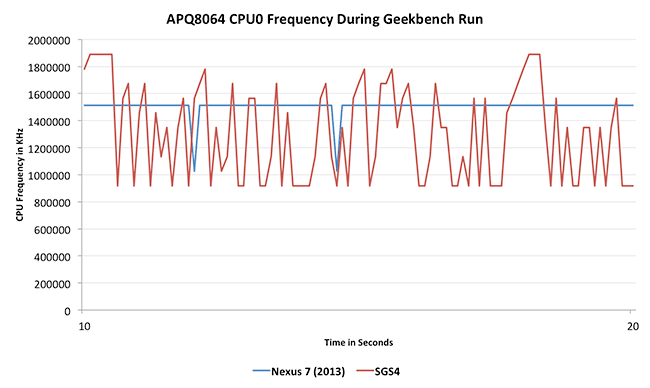
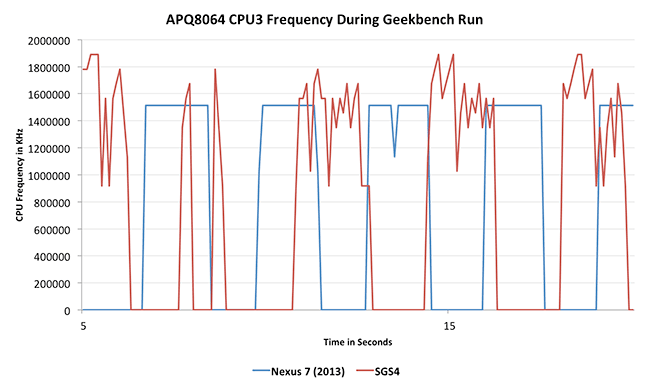








202 Comments
View All Comments
scavio - Thursday, August 22, 2013 - link
Seems odd that you compare the display to an iPad 4 and say you won't even bother comparing it to other android tablets. As far as I can tell you don't even include the iPad 4 in any of the graphs except pixel density and do include a bunch of android tablets.andykins - Thursday, August 22, 2013 - link
I noticed that too. You should include the retina ipad display in the graphs imo. Also redefines has been misspelt on the final paragraph of final words.Good article. Tempting :)
Anand Lal Shimpi - Thursday, August 22, 2013 - link
Fixed :)scavio - Thursday, August 22, 2013 - link
Thanks! The numbers really are close, I'm impressed.jiffylube1024 - Thursday, August 22, 2013 - link
Some of the tests (eg 3d mark) don't run on iOS, which explains the ipad 4's absence.mmarafie - Thursday, August 22, 2013 - link
The comparison to the iPad 4 is a way to detract from the real competitor to Nexus 7, the iPad mini. Not only does the Nexus 7 offer much better color accuracy than the iPad mini, it also has double the pixel density at 323 compared to 163...Anand calls the SOC in the N7 "performance mainstream" which has a Quad Core Krait @ 1.5GHz and 2GB RAM. Yet he omits to mention the paltry (2 year old) SOC in the iPad mini a Cortex A8 based Dual Core CPU running 1GHz with 512MB RAM and a GPU that is less than half the power of the Adreno 320 in the N7...mmarafie - Thursday, August 22, 2013 - link
Yes in general, apps are still slightly better optimized on iOS, but Android apps are closing in fast not only in quantity but also in quality. So a properly optimized app on N7 can easily get 2 to 4x CPU/GPU power compared to iPad mini. Also Anand omits mentioning the price deference between the N7 at only $240 compared with the iPad mini at $340. I understand the better build quality on the iPad, but paying $100 more for the comparatively pixelated screen and weak hardware of the iPad mini is just plain ridiculous...For the 32GB 4G version it gets even worse, the N7 costs only $350, while the iPad mini costs $660! Is this a joke or what? Again Anand omits to mention any of that...mmarafie - Thursday, August 22, 2013 - link
Sorry, meant to say $560 for the 32GB 4G version of the iPad minidyc4ha - Thursday, August 22, 2013 - link
Well, the fact that it is being compared to Apple's flagship tablet says mighty much already... I do not see the need to compare it directly with the Mini because, well, there isn't a comparison. I enjoyed the review btw, keep it up!mmarafie - Friday, August 23, 2013 - link
If someone is in the market for a smaller tablet say in the 7 to 8" size range, then they would be looking at say the Nexus 7, iPad mini, Galaxy Tab 3 and Note 8.0, Asus MeMo Pad etc. So these are the tablets that should be compared directly with each other in review. Although it's still a good idea to have benchmarks of the larger tablets for comparison too.To me the review is incomplete and omitting some variables that could help the buyer make an informed decision.